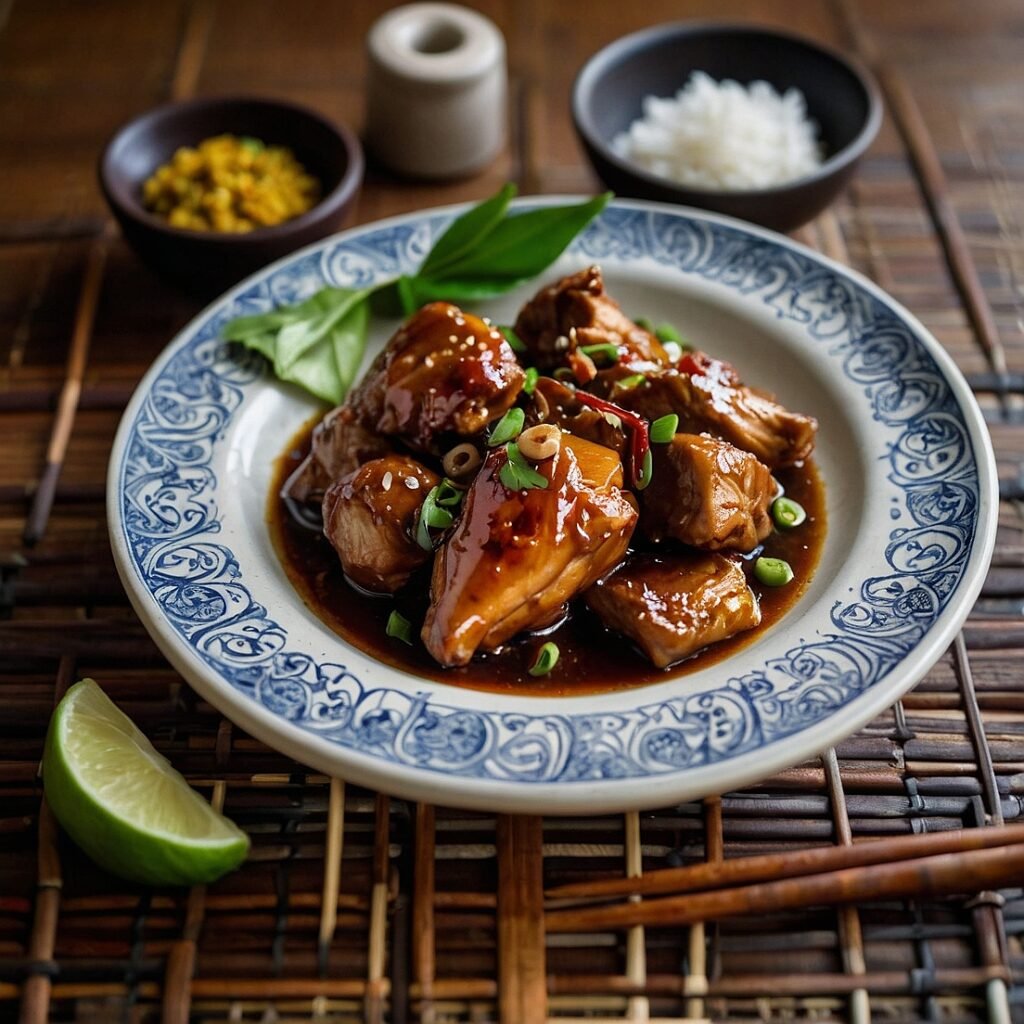Welcome, food lovers and culinary adventurers! Today, we’re diving deep into the heart of Filipino cuisine to explore a dish that’s not just a meal, but a cultural icon. That’s right, we’re talking about adobo – the unofficial national dish of the Philippines. Whether you’re a seasoned adobo aficionado or a curious newcomer, this blog will take you on a flavorful journey through the history, variations, and secrets of this beloved Filipino staple. So, grab a seat at the table, and let’s unravel the delicious mystery that is adobo!
The Origins of Adobo: A Tasty Trip Through Time
A Dish Born from Necessity
Let’s start our adobo adventure by turning back the pages of history. Adobo, as we know it today, has roots that stretch far beyond the Spanish colonial era, contrary to what many might believe. The method of cooking meat in vinegar and salt was a common preservation technique used by indigenous Filipinos long before the arrival of the Spanish conquistadors. This practical approach to keeping food fresh in a tropical climate laid the groundwork for what would eventually become the adobo we know and love today.
The Spanish Influence
When the Spanish arrived in the Philippines in the 16th century, they encountered this cooking method and named it “adobo,” which comes from the Spanish word “adobar,” meaning “to marinate” or “to pickle.” However, it’s crucial to note that Filipino adobo is distinct from Spanish adobo or other Latin American versions. The Spanish contribution was primarily in naming the dish and introducing new ingredients like bay leaves and black peppercorns, which are now staple components of many adobo recipes.
Evolution Through the Ages
As time passed, adobo continued to evolve. Chinese traders brought soy sauce to the Philippines, which was incorporated into some versions of adobo, adding depth and umami to the dish. The American occupation in the 20th century introduced new cooking techniques and kitchen appliances, further influencing how adobo was prepared and consumed. Today, adobo stands as a testament to the Philippines’ rich history, a culinary embodiment of the various cultural influences that have shaped the nation.
The Adobo Basics: Breaking Down the Dish
The Core Ingredients
At its heart, adobo is a simple dish with complex flavors. The basic ingredients typically include:
- Meat (usually chicken or pork, but can vary)
- Vinegar
- Soy sauce (in many, but not all, versions)
- Garlic
- Black peppercorns
- Bay leaves
These ingredients come together to create a perfect balance of sour, salty, and savory flavors that dance on your taste buds. The beauty of adobo lies in its simplicity – these few ingredients, when combined, create a dish that’s greater than the sum of its parts.
The Cooking Process
The traditional method of cooking adobo involves marinating the meat in vinegar, soy sauce, and spices, then simmering it until the meat is tender and the sauce has reduced to a rich, flavorful gravy. Some cooks prefer to brown the meat first, while others add it directly to the marinade. The long, slow cooking process allows the flavors to meld and intensify, resulting in meat that’s fall-off-the-bone tender and infused with the tangy, savory essence of the sauce.
The Role of Vinegar
Vinegar is the star player in adobo, giving the dish its characteristic tang and serving as a natural preservative. Different regions in the Philippines use various types of vinegar, from coconut vinegar to cane vinegar, each imparting its unique flavor profile to the dish. The acidity of the vinegar not only adds flavor but also helps to tenderize the meat, making adobo a perfect dish for tougher cuts of meat.
Regional Variations: A Flavorful Tour of the Philippines
Adobong Puti: The Original White Adobo
Let’s start our regional adobo tour with a trip to the Visayas region, where you’ll find adobong puti or white adobo. This version is believed to be closer to the pre-colonial adobo, using only vinegar, salt, garlic, and peppercorns – no soy sauce in sight. The result is a lighter-colored dish with a bright, tangy flavor that lets the vinegar shine. It’s a testament to the dish’s roots and a delicious alternative for those looking to experience adobo in its most traditional form.
Adobo sa Gata: A Creamy Twist
Venture to the Bicol region, known for its love of coconut milk, and you’ll discover adobo sa gata. This variation adds coconut milk to the traditional adobo recipe, resulting in a creamier, more indulgent dish. The coconut milk mellows out the tanginess of the vinegar and adds a rich, tropical flavor that perfectly complements the savory meat. It’s a prime example of how regional ingredients can transform a classic dish into something entirely new and exciting.
Adobong Dilaw: The Golden Adobo
In parts of Luzon, particularly in Batangas, you might come across adobong dilaw or yellow adobo. This vibrant variation gets its golden hue from the addition of turmeric, known locally as luyang dilaw. The turmeric not only adds color but also brings its earthy, slightly bitter flavor and potential health benefits to the dish. It’s a visual and flavorful departure from the typical brown adobo that showcases the diversity of Philippine cuisine.
Adobong Pusit: Seafood Twist
Who says adobo has to be all about meat? In coastal regions, you’ll find adobong pusit, a squid adobo that turns the sauce a dramatic black thanks to the squid ink. This variation offers a briny, oceanic twist on the classic adobo flavors, demonstrating the versatility of the adobo cooking method. It’s a favorite among seafood lovers and a must-try for anyone looking to explore the full spectrum of adobo variations.
The Secret to Perfect Adobo: Tips from Filipino Kitchens
Choosing Your Vinegar
The type of vinegar you use can make or break your adobo. While any vinegar will work in a pinch, traditional Filipino vinegars like cane vinegar or coconut vinegar will give your adobo that authentic taste. These vinegars tend to be less sharp than Western white vinegar, providing a more rounded, complex flavor. If you can’t find Filipino vinegars, try apple cider vinegar as a substitute – it has a similar mild acidity that works well in adobo.
The Soy Sauce Debate
While many modern adobo recipes include soy sauce, purists argue that true adobo doesn’t need it. If you do use soy sauce, opt for a Filipino brand if possible, as they tend to be saltier and more robust than other Asian soy sauces. Remember, the goal is to balance the sour and salty flavors, so adjust your vinegar and soy sauce ratios until you find your perfect blend.
Marination: Patience is a Virtue
For the most flavorful adobo, marination is key. While you can cook adobo immediately after mixing the ingredients, allowing the meat to marinate for at least an hour (or overnight if you have the time) will result in more tender, flavorful meat. The vinegar in the marinade helps to break down the proteins in the meat, allowing the flavors to penetrate deeper.
The Art of Reduction
The final step in cooking adobo is reducing the sauce to concentrate the flavors. Don’t rush this process – let the sauce simmer gently until it reaches your desired consistency. Some prefer a saucy adobo, while others like it almost dry. There’s no right or wrong here; it’s all about personal preference. Just remember that as the sauce reduces, the flavors intensify, so taste and adjust seasoning as you go.
Beyond the Basics: Creative Adobo Variations
Vegetarian and Vegan Adobo
Who says adobo has to be all about meat? Creative cooks have developed delicious vegetarian and vegan versions of adobo that capture the essence of the dish without animal products. Popular variations include adobong kangkong (water spinach), adobong talong (eggplant), and even adobong tokwa (tofu). These plant-based adobos prove that the magic of adobo lies in its flavors, not just its traditional ingredients.
Fusion Adobo: A Global Twist
As Filipino cuisine gains global recognition, innovative chefs are incorporating adobo flavors into fusion dishes. You might find adobo tacos, adobo pizza, or even adobo-flavored potato chips! These creative interpretations show how versatile and beloved adobo flavors are, capable of transcending cultural boundaries and inspiring new culinary creations.
Adobo in a Jar: Preserving Tradition
In recent years, bottled adobo sauces and marinades have hit the market, allowing busy home cooks to enjoy adobo flavors without the long cooking process. While purists might scoff, these products have helped to spread the love of adobo to a wider audience and provide a convenient way for overseas Filipinos to enjoy a taste of home. They’re also a great starting point for those new to Filipino cuisine who want to experiment with adobo flavors in their cooking.
The Cultural Significance of Adobo
A Dish That Unites
Adobo is more than just a meal; it’s a cultural touchstone for Filipinos. In a country with over 7,000 islands and numerous ethnic groups, adobo serves as a unifying dish that transcends regional and cultural boundaries. Almost every Filipino has a favorite adobo recipe, often passed down through generations, making it a dish that connects people to their heritage and family history.
Adobo Diplomacy
The popularity of adobo has made it an unofficial ambassador for Filipino cuisine on the global stage. Filipino restaurants abroad often feature adobo as their signature dish, introducing international diners to the flavors of the Philippines. It’s not uncommon to hear stories of foreigners falling in love with Filipino culture through a plate of adobo, showcasing the dish’s power as a cultural bridge-builder.
Adobo in Pop Culture
The cultural importance of adobo is reflected in its prominence in Filipino pop culture. From songs about adobo to adobo-themed merchandise, the dish has become a symbol of Filipino identity and pride. Social media is filled with adobo posts, recipes, and debates, showing how this humble dish continues to captivate and unite Filipinos in the digital age.
Adobo: A Gateway to Filipino Cuisine
Exploring Beyond Adobo
While adobo is undoubtedly a star of Filipino cuisine, it’s just the beginning of what this diverse culinary landscape has to offer. For those who’ve fallen in love with adobo, it can serve as a gateway to exploring other Filipino dishes. From the sour notes of sinigang to the rich, peanutty flavors of kare-kare, Filipino cuisine is full of unique and delicious dishes waiting to be discovered.
Adobo as a Cooking Method
Understanding adobo can also help in appreciating the broader principles of Filipino cooking. The balance of sour, salty, and savory flavors found in adobo is a common thread running through many Filipino dishes. Learning to perfect your adobo can teach you about flavor balance, the importance of quality ingredients, and the patience required for slow-cooked dishes – all valuable skills for anyone looking to delve deeper into Filipino or Southeast Asian cuisine.
The Future of Adobo
As Filipino cuisine continues to gain recognition worldwide, adobo is likely to evolve and adapt. We’re already seeing innovative chefs putting new spins on this classic dish, incorporating global ingredients and techniques while staying true to its essence. The future of adobo is exciting, with endless possibilities for new variations and interpretations that will keep this beloved dish relevant for generations to come.
Conclusion: The Timeless Appeal of Adobo
As we come to the end of our adobo journey, it’s clear why this dish has captured hearts and palates around the world. Adobo is more than just a recipe; it’s a testament to the ingenuity, adaptability, and rich cultural heritage of the Filipino people. From its humble origins as a preservation method to its status as a beloved national dish, adobo has stood the test of time, evolving with the culture while maintaining its essential character.
Whether you prefer your adobo tangy and saucy, dry and intensely flavored, or with a creative twist, there’s an adobo out there for everyone. Its simplicity makes it accessible to home cooks, while its depth of flavor challenges even the most experienced chefs. So why not give adobo a try in your own kitchen? Experiment with different meats, vinegars, and regional variations. You might just find that this Filipino classic becomes a new favorite in your culinary repertoire.
Remember, every plate of adobo tells a story – of family traditions, regional pride, and the rich tapestry of Filipino culture. So the next time you enjoy a bowl of adobo, take a moment to appreciate not just the flavors, but the history and love cooked into every bite. Happy cooking, and may your adobo adventures be delicious!
Disclaimer: While every effort has been made to ensure the accuracy of the information presented in this blog post, culinary traditions and recipes can vary widely across regions and families. The author acknowledges that personal experiences and regional variations may differ from the information provided. We encourage readers to explore the rich diversity of adobo recipes and to share their own experiences and variations. If you notice any inaccuracies or have additional insights to share, please don’t hesitate to reach out so we can continue to improve and expand our understanding of this beloved dish.




